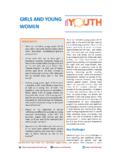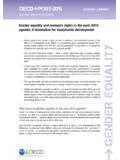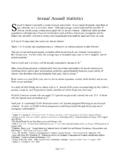Transcription of Harnessing the Power of Data for Girls - Home …
1 Harnessing the Power of data for GirlsTaking stock and looking ahead to 2030 United Nations Children s Fund (UNICEF) Division of data , Research and Policy, October reasonable precautions have been taken by UNICEF to verify information contained in this publication. For corrigenda subsequent to printing, please see is required to reproduce any part of this publication. Permissions will be freely granted to educational or non-profit organisations. Please contact: data and Analytics Section Division of data , Research and Policy 3 UN Plaza, New York, NY citation: United Nations Children s Fund, Harnessing the Power of data for Girls : Taking stock and looking ahead to 2030, UNICEF, New York, 2016. The 2030 Agenda for Sustainable Development sets out an ambitious vision for universal progress on urgent issues over the next 15 years. Building on achievements to date, the Agenda commits us to meeting the Sustainable Development Goals (SDGs) for all nations and people and for all segments of society and pledges to leave no one behind.
2 This presents a critical opportunity to advance the well-being and empowerment of a large segment of the world population that is at risk of being left out of global progress: billion OF Girls IN THE SDGS data tell us that the lives of Girls today are better in many respects than those of preceding generations. Girls are now more likely to survive childhood, more likely to attend school and complete their education, less likely to be undernourished and less likely to marry as children. Yet Girls still suffer significant deprivations and inequalities, many of which result from the persistent gender discrimination faced by Girls and women everywhere. And for many Girls , further disadvantage based on disability, location, race, ethnicity or migration status compounds the challenges of building a fulfilling the SDGs will not be possible without reaching all Girls , starting with the most disadvantaged. For example:Goal 3 calling for good health and well-being for all will not be achieved if adolescent Girls , who currently account for nearly two in three new HIV infections in their age group, are not reached with prevention and treatment 4 of inclusive, quality education for all will not be achieved if Girls remain notably disadvantaged in educational access, completion and learning outcomes in a number of 5 calling for gender equality and ending all forms of discrimination against Girls and women will not be achieved if one in four Girls still marry in childhood and the practice of female genital mutilation/cutting (FGM/C)
3 Continues unabated in some 16 to promote peaceful and inclusive societies cannot be attained if prevailing gender discrimination and norms in many parts of the world continue to relegate Girls to a lower status within society and their own families, leaving them vulnerable to exploitation and violence, including trafficking and sexual change for Girls and progress towards achieving the SDGs will require investments from governments, donors and development organizations. This includes prioritizing infrastructure, goods and services that address Girls vulnerabilities and remove barriers to their empowerment. But it will also require engagement from communities, social networks, families and Girls themselves. Investing in data will be especially critical to monitor SDG progress and ensure accountability, as well as to increase understanding of Girls ongoing and emerging challenges and disadvantages as the world changes between now and the commitments laid out in the new Agenda will not only improve the lives of today s billion Girls and support their transition to adulthood; it will also build a better world so the next generation of Girls can thrive.
4 The stakes are high, especially since these Girls will increasingly be born into areas of the world where deprivations are especially acute. THE SDG GENERATION Nearly nine in 10 Girls today live in low- and middle-income countries a pattern that is expected to continue through world today is home to billion Girls under age 18. More than half of them live in Asia and a quarter live in Africa. Demographic projections indicate that while most regions will have a similar or smaller number of Girls by 2030, the number of African Girls will grow by 30 per cent between 2015 and million Girls were born in 2015, beginning their lives just as the world embarks on the SDGs. These Girls are expected to live on average 73 years. The expected life spans of Girls born in low-income countries are almost 20 years shorter than those born in high-income countries. Measuring gender inequalities in under-5 mortality rates (U5MR) is complex. Generally, Girls tend to have better biological endowments than boys for survival to age five, and thus higher survival chances under natural circumstances, but sex discrimination can affect the odds.
5 Gender parity therefore does not mean that Girls and boys have an equal risk of dying, rather that the rates are proportionate to biological determinants. The global U5MR is 41 and 44 deaths per 1,000 live births for Girls and boys, CONTINUING DISADVANTAGES Available data suggest that gender disparities in early childhood are relatively small for many indicators, including those in the SDGs. Overall, children are equally likely to be registered at birth irrespective of sex (around 70 per cent). In about half of countries with available data , Girls are more likely to be developmentally on track at ages 3 and 4 than boys, while in the remaining countries there are no sex differences with regards to developmental status, and globally Girls are just as likely as boys to participate in pre-primary education (66 per cent). In most countries, Girls and boys are at about equal risk of experiencing violent punishment by caregivers in the home.
6 This said, however, significant gender differentials persist in some domains and in certain countries. For example, while gender parity in under-5 mortality has been achieved at the global level, notable gaps persist in nine countries primarily located in South Asia and the Middle East where Girls risk of dying before age 5 is significantly higher than would be expected. Gender disparities become more pronounced as children approach adolescence. The onset of puberty magnifies biological differences between Girls and boys and introduces issues and risks unique to or exacerbated for Girls . As shown below, this can result in adverse outcomes for adolescent Girls . 32 million Girls are out of school at the primary level and 29 million at the lower secondary level. While more than two thirds of countries have reached gender parity in primary education, less than half have achieved parity at the secondary level. The largest gender gaps are in West and Central Africa, where 79 Girls are enrolled in secondary school for every 100 boys.
7 In three quarters of the low- and middle-income countries with available data , more than one in five adolescent Girls have experienced violence at the hands of their partner in the past 12 months. Suicide is the leading cause of death among adolescent Girls aged 15 19 globally, with the highest rates seen in South-East Asia (one in six deaths among adolescent Girls ). Homicide rates are not as high for Girls as for boys, accounting for 30 per cent and 70 per cent of victims under age 20, respectively. Perpetrators differ by sex of the victim: globally, almost half (47 per cent) of female homicide victims of all ages are killed by family members or intimate partners, whereas the figure for males is 6 per cent. Despite evidence of declines, around one in three Girls aged 15 19 today have undergone FGM/C in the countries where it is practised. In sub-Saharan Africa, the region most heavily affected by HIV, three in four newly infected adolescents aged 15 19 are Girls .
8 Worldwide, almost 750 million women and Girls alive today were married before their 18th birthday. While there has been a decrease in child marriage globally, progress has not been equitable; high levels have persisted among the poorest while declines have been limited to the richest. In the least developed countries, over one in four young women aged 20 24 around 12 million women have had a live birth before age 18. Similar proportions are observed in sub-Saharan Africa. Globally, less than 40 per cent of pregnant adolescent Girls (younger than 20) have their first antenatal care visit within the first trimester as recommended. In sub-Saharan Africa and South Asia, half of births to adolescent mothers are not attended by skilled health personnel. Nine in 10 people worldwide use improved drinking water sources, including nearly six in 10 who use water piped on premises. In households without a water source on premises, Girls and women are those primarily responsible for water collection.
9 In sub-Saharan Africa, one round trip to collect water takes around 33 minutes on average in rural areas and 25 minutes in urban areas. This is time that could be spent on productive or leisure activities. Water collection often results in injuries, especially to young Girls and pregnant women; it can also expose Girls to risks of sexual violence while travelling back and , Girls aged 5 14 spend 550 million hours every day on household chores, 160 million more hours than boys their age spend. A girl aged 5 9 spends an average of almost four hours per week on household chores while older Girls aged 10 14 spend around nine hours per week on these activities. In some regions and countries, these numbers are twice as HOURS / DAY HOURS / WEEK COOK AND CLEAN IN THE HOMEIn the three countries with the highest prevalence of involvement in household chores, on average, more than half of Girls aged 5 14 spend at least 14 hours per week, or at least two hours per day, on household chores (Somalia 64 per cent, Ethiopia 56 per cent and Rwanda 48 per cent).
10 Worldwide, Girls aged 5 9 and 10 14 spend, respectively, 30 per cent and 50 per cent more of their time helping around the house than boys of the same age. In some regions, the gender disparities can be even more severe: In the Middle East and North Africa and South Asia regions, Girls aged 5 14 spend nearly twice as many hours per week on household chores as boys of the same age. In countries with available data on chores by type, almost two thirds of Girls aged 5 14 (64 per cent) help with cooking or cleaning the house. The second most commonly performed task among Girls this age is shopping for the household (50 per cent), followed by fetching water or firewood (46 per cent), washing clothes (45 per cent), caring for other children (43 per cent) and other household tasks (31 per cent). % MORE TIME SPENT ON CHORES THAN BOYSGIRLS TIME SPENT ON HOUSEHOLD CHORESIt is increasingly acknowledged that the unequal distribution of household chores has negative impacts on Girls and women s lives.
















